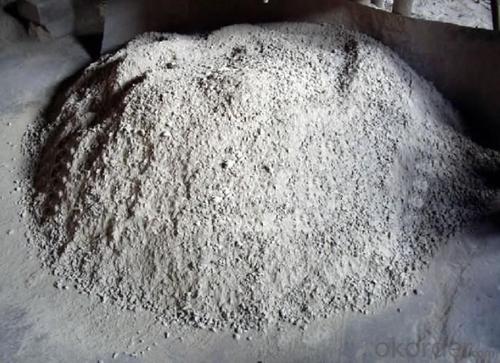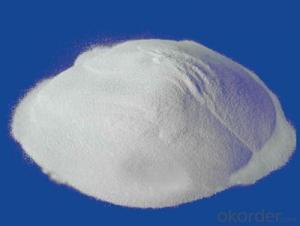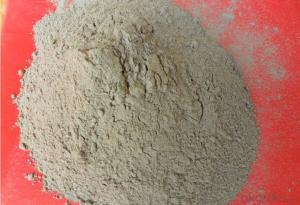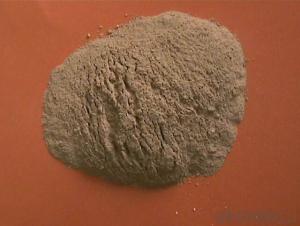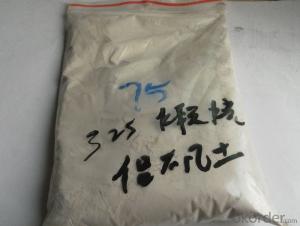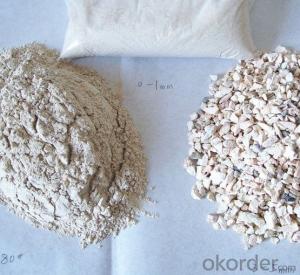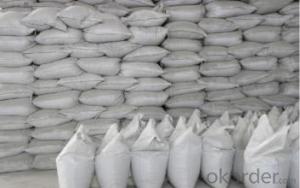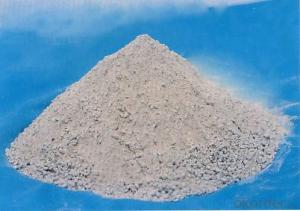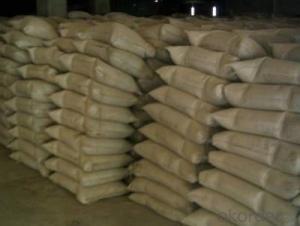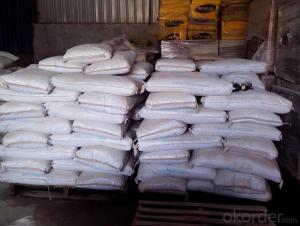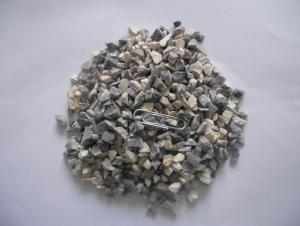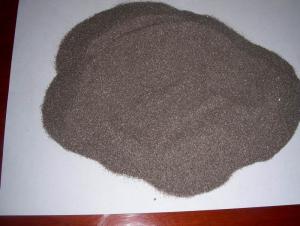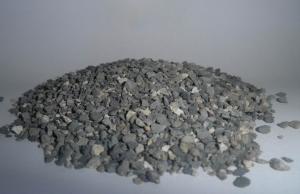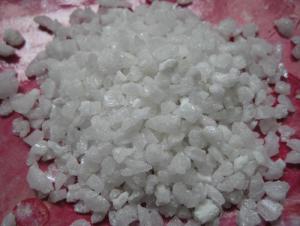High Temperature Calcium Aluminate High Alumina Cement - Raw Materials for Refractory
- Loading Port:
- China main port
- Payment Terms:
- TT OR LC
- Min Order Qty:
- 25 m.t.
- Supply Capability:
- 2000 m.t./month
OKorder Service Pledge
Quality Product, Order Online Tracking, Timely Delivery
OKorder Financial Service
Credit Rating, Credit Services, Credit Purchasing
You Might Also Like
Product Description
| Description of calcium aluminate high alumina cement |
The calcium aluminate high alumina cement is made by bauxite and lime as raw material,calcined and grinded after compounding with certain rate.
| Advantages of calcium aluminate high alumina cement |
The calcium aluminate high alumina cement has high strength and easy to construct.
| Applications of calcium aluminate high alumina cement |
The calcium aluminate high alumina cement can be used to compound the unshaped refractory and for some rush-to-build constructions.
| Physical and Chemical Indexes |
| Characteristic | Item | Unit | calcium aluminate high alumina cement | |||
| A600 | A900 | CA-70 | CA-80 | |||
| Superficial area | / | m²/kg | 354.8 | 425.2 | 612 | 608 |
| Chemical contents | SiO2 | % | 7.81 | 5.86 | 0.32 | 0.28 |
| Al2O3 | % | 51.26 | 54.12 | 73.68 | 78.86 | |
| Fe2O3 | % | 1.78 | 1.72 | 0.32 | 0.15 | |
| R2O | % | 0.26 | 0.23 | 0.2 | 0.21 | |
| Setting time | Initial setting time | minute | 128 | 205 | 109 | 68 |
| Final setting time | minute | 159 | 287 | 172 | 121 | |
| Rupture strength | 1 day | Mpa | 6.1 | 9.2 | 8.2 | 5.7 |
| 3 days | Mpa | 7.1 | 11.1 | 10.2 | 7.7 | |
| 110℃ | Mpa | / | / | 12 | 8.9 | |
| Compressive strength | 1 day | Mpa | 52.4 | 72.5 | 55.8 | 43.2 |
| 3 days | Mpa | 56.8 | 81.9 | 70.6 | 55.4 | |
| 110℃ | Mpa | / | / | 89.8 | 80.8 | |
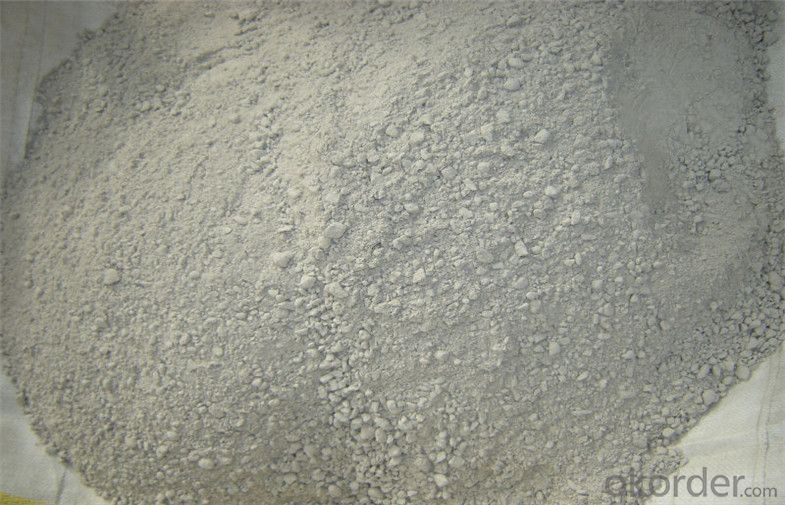
- Q: what's the application of fireproofing abs materials?
- ABS is acronym of Acrylonitrile Butadiene Styrene )it is a kind of thermoplastic high polymer material with properities of high strength, good toughness, easy processing and molding. it has high strength, corrosion resistance, high temperature resistant, so it's often used in the plastic shell manufacture of instruments.
- Q: What materials is silicious thermal insulation board made of?
- Refractories that contain more than 93% of the monox are acidic refractory materials which include ordinary silica brick, high-density and high-purity silica brick, silica brick that contains chromium, fused quartz products, unburned brick and siliceous ramming materials. It has good softening temperature under a fixed load and can resist corrosion of acid slag, but will have chemical reaction with alkaline slag. Silicious refractory of industrial value mainly is crystalline quartz, such as α and β quartz, tridymite and cristobalite.
- Q: What's the texture of refractory for the hearth of reverberatory?furnace? ?
- High alumina brick; you can use zircon brick under the temperature above 1700? ;may i use mullite bricks under the temperature from 1400 to 1700? you can use clay brick and heavy corundum brick under the temperature of below 1400 degrees, question closely: what's the usage temperature of reverberatory?furnace? < pre accuse = "qRA" > is there someone use refractory fiber?
- Q: How to divide the materials according to the National Fireproofing Material Standard?
- 2,generally, the external wall thermal insulation materials is divided in accordance with fire rating: 1, the class A combustion performance of insulation materials : inorganic fiber spray coating, glass wool, foam glass, foamed ceramics, rock wool, foam cement, hole-closed perlite ect.. 2) class B1 combustion performance of thermal insulation materials: Extruded polystyrene board (XPS) after special treatment / Special treatment of polyurethane (PU), phenolic aldehyde, gelatine powder polyphenyl granule, etc. 3) combustion performance of class B2 insulation material: molding polystyrene board(EPS), extruded polystyrene board (XPS), polyurethane (PU), polyethylene (PE), etc. I hope it will be helpful for you
- Q: Do you know the refractories?
- Definition of refractory: inorganic non-metallic material with fire resistance greater than 1580 degrees is refractory.Refractory material is a part of material industry. It is named refractory material for thermal kiln. Refractory materials are divided into conventional refractory materials and special refractory materials, and conventional refractory materials are used in metallurgical furnaces, cement kilns, glass kilns and other thermal furnace lining materials, mostly processed from natural raw materials. Special refractory materials are of high purity, mostly oxide synthetic materials, used in special smelting equipment, or special parts of kilns.
- Q: Who knows the model of fireproofing materials?
- Inorganic binder: it mainly includes sodium silicate, gypsum, phosphate, cement,etc; refractory mineral filler: aluminium oxide, asbestos powder, calcium carbonate, perlite, cornstarch,etc; nonflammable organic resin: it mainly includes polyvinyl chloride, perchloro-ethylene, chlorinated rubber, neoprene latex, epoxy resin, phenol resin,etc. Nonflammable fireproof addictive: it mainly includes phosphorus, halogens, nitrogen organic compounds (chlorinated paraffins, TBP ( tributyl phosphate ), decabromodiphenyl ether), and borate series (boric acid, zinc borate, aluminium borate), antimony series, aluminium series, zirconium series and other inorganic compounds.
- Q: who knows the requirements of refractory for forge furnace?
- Forging heating furnace working temperatures above 1000 ° C, reasonably choosing refractory for build furnace has an important meaning for guaranteeing the normal operation of the heating furnace, improving the service life of furnace and energy saving. refractory is generally required to have the following properities: 1, it should be equipped with the properity of no deformation and melting under certain temperature. 2, it should be equipped with the neccessary structural strength without softening deformation in high temperature. 3, volume stability at high temperature, brick body won't be deformation or cracked due to expansion and contraction; 4, not broken and peel off under rapid changes of temperature or uneven heating; 5, resistant to chemical erosion of molten metal, slag and furnace gas,etc.
- Q: What are the new types of refractories? What are the characteristics? Their applications and developments?
- Special materials often use AZS brick, corundum brick, magnesia chrome brick, silicon carbide, silicon nitride bonded silicon carbide, nitrides, silicides, sulfide, boride, carbide and other non oxide refractory materials; calcium oxide, chromium oxide, alumina, Magnesium Oxide, beryllium and other refractory materials. Often used insulation refractories are diatomite products, asbestos products, insulation panels and so on. Unshaped refractory materials commonly used are fettling, refractory ramming material, refractory castable, refractory plastic material, refractory clay, refractory gunning, refractory cast material, fireproof coating, lightweight castable, mud etc..
- Q: Who knows the texture of fire-proof wooden door material?
- The so-called fire doors are only posted a layer of fireproof material. Door selection still depends on the timber inside. The simplest way is to see the weight value, fireproof material layer, and they are generally paint-free doors. With fireproofing function.. Hope you adopt.
- Q: what textures of furnace refractories are good?
- The common one uses the ordinary aluminous fireclay brick and GB / T 3994-2005 insulating fireclay brick. The ones with excellet texture are high-grade thermal insulation refractory brick and GB / T 3995-2006 high alumina insulating firebrick, whose model is A13, the texture is alumina, A13 50u, advanced heat insulating brick B5; intermediate heat insulating brick B2, and so on. Dolomite brick: The formation of coating is of good performance and corrosion resistance, but to some extent, there exsits the f-CaO in the brick, which is easy to hydrate, and hard to transport and storage, thus less using in the production. Magnesia-chrome brick: The formation of coating is good, so it is widely used for burning zone, but the disadvantage is poor thermal shock resistance, coupled with the highly toxic positive Hexavalent Cr, so the international countries that produce and use the magnesia-chrome bricks are gradually reducing. The production unit using this brick now, please find alternatives as soon as possible.
Send your message to us
High Temperature Calcium Aluminate High Alumina Cement - Raw Materials for Refractory
- Loading Port:
- China main port
- Payment Terms:
- TT OR LC
- Min Order Qty:
- 25 m.t.
- Supply Capability:
- 2000 m.t./month
OKorder Service Pledge
Quality Product, Order Online Tracking, Timely Delivery
OKorder Financial Service
Credit Rating, Credit Services, Credit Purchasing
Similar products
Hot products
Hot Searches
Related keywords


